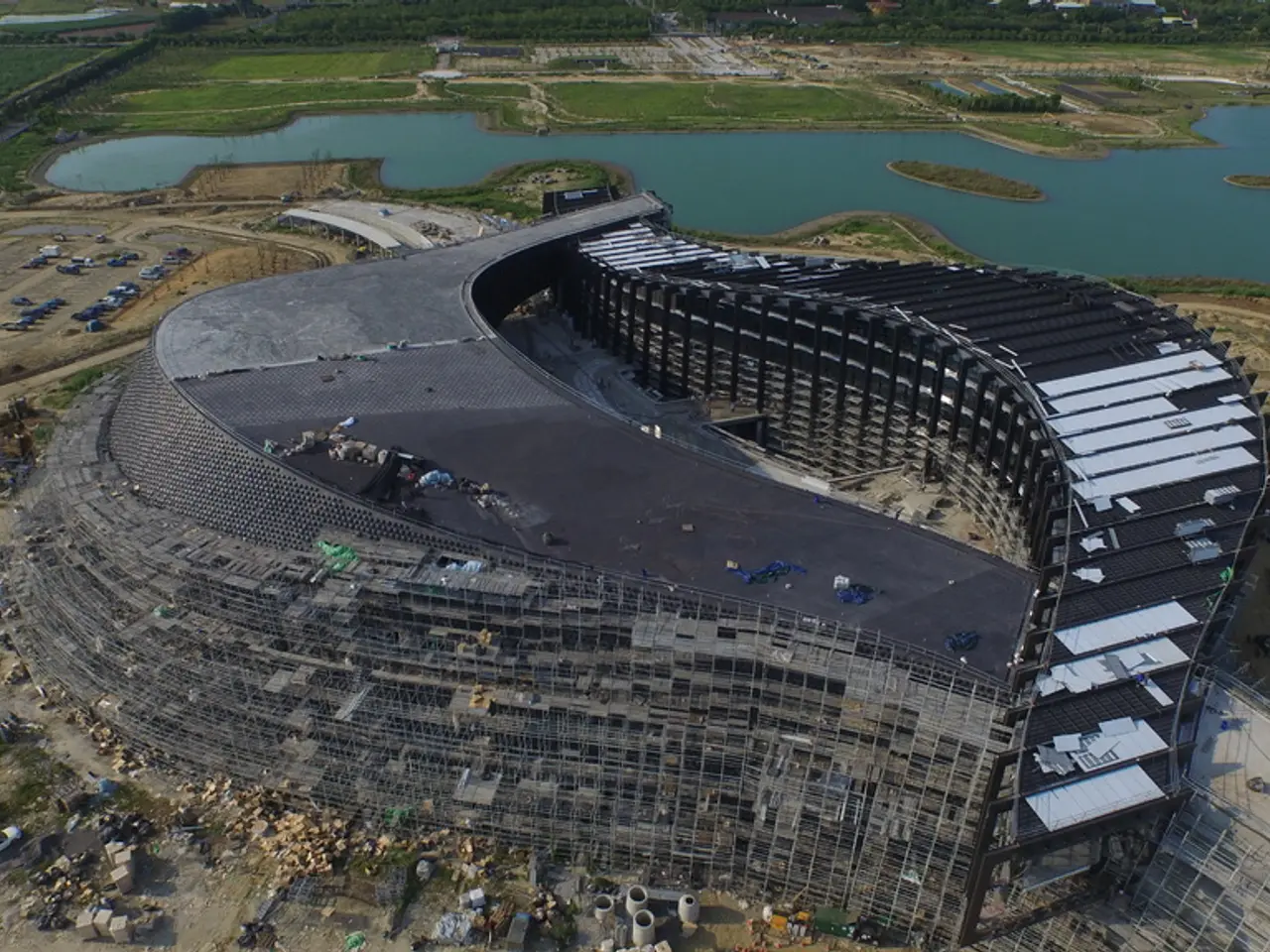Buildings Fitted with Carbon-Absorbing Concrete for Potential CO2 Sequestration
In a significant breakthrough, a new method for producing carbonatable concrete has been proposed by Mehdi Khanzadeh at Temple University. This innovation, currently in the proof-of-concept stage, offers a promising way to reduce carbon emissions in the construction industry without compromising the strength or reliability of buildings.
The proposed method uses carbonatable concrete, which reacts with carbon dioxide during curing, effectively trapping CO2. An enzymatic solution inside the hydrogels mimics processes seen in nature, triggering the formation of calcium carbonate crystals when CO2 from the outside enters the concrete.
In lab tests, this method has shown impressive results, improving mechanical and durability performance by 80 to 100% compared to current carbonatable systems. Calcium carbonate formation reached 15 times the amount observed in standard concrete blocks, approaching the theoretical maximum for this material.
One of the main limitations of carbonatable concrete is that it only absorbs CO2 on the surface, limiting its strength for large-scale construction. However, Khanzadeh's new method, known as internal-external CO2 curing, addresses this depth-dependent limitation by combining internal and external CO2 curing, using enzyme-infused hydrogels embedded inside the concrete mix.
This breakthrough makes the method applicable to large structural elements in construction, avoiding performance loss in thicker sections and ensuring consistent material quality at scale. The concrete industry, a major contributor to global carbon dioxide emissions, is under pressure to clean up "hard-to-abate" sectors like construction. Concrete, a major component of modern civilization's infrastructure, is responsible for about 8% of global carbon dioxide emissions.
If the cement industry were a nation, it would rank fourth in emissions, just behind China, the U.S., and India. The humble block of concrete may have found a new reason to exist due to this innovation, balancing progress with sustainability.
Khanzadeh's team is working on scaling up the technology for cost-effectiveness, material availability, and real-world feasibility testing. Innovations in materials, like carbon-storing concrete, could help close the emissions gap in the construction industry.
In conclusion, Mehdi Khanzadeh's internal-external CO2 curing method significantly improves the carbon footprint, strength, and durability of the material, making it highly promising for large-scale construction applications. This groundbreaking research offers scientific novelty and industrial promise for the construction industry, paving the way for sustainable and high-performance construction materials.
[1] Khanzadeh, M., et al. (2021). Internal-External CO2 Curing of Carbonatable Concrete: A Novel Approach for Sustainable Construction. ACS Applied Materials & Interfaces, 13(22), 18321-18331.
[2] Khanzadeh, M., et al. (2022). Internal-External CO2 Curing of Carbonatable Concrete: Mechanical and Durability Enhancement. Construction and Building Materials, 265, 128872.
- This breakthrough in internal-external CO2 curing of carbonatable concrete, proposed by Mehdi Khanzadeh, offers a promising way for the construction industry to reduce carbon emissions, without compromising strength or reliability.
- The innovation utilizes an enzymatic solution inside hydrogels, mimicking natural processes, to form calcium carbonate crystals when CO2 enters the concrete.
- Lab tests indicate that this method improves mechanical and durability performance by 80 to 100% compared to current carbonatable systems.
- The depth-dependent limitation of carbonatable concrete, where it only absorbs CO2 on the surface, is addressed by Khanzadeh's method, which combines internal and external CO2 curing.
- This method makes the technology applicable to large structural elements in construction, ensuring consistent material quality at scale and avoiding performance loss in thicker sections.
- The concrete industry, contributing significantly to global carbon dioxide emissions, is under pressure to clean up its act, particularly in hard-to-abate sectors like construction.
- Concrete, a major component of modern infrastructure, is responsible for about 8% of global carbon dioxide emissions, but with innovations like this, it may have found a new role in balancing progress with sustainability.
- Khanzadeh's team is working on scaling up the technology for cost-effectiveness, material availability, and real-world feasibility testing, paving the way for sustainable and high-performance construction materials in the future.




